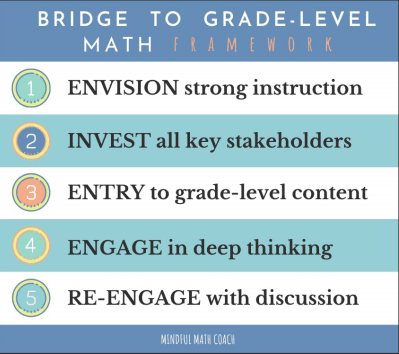This blog post was originally published on Mindful Math Coach, which aims to support secondary math educators to provide equitable learning experiences for students of color, leading to equitable outcomes. The site offers a variety of free resources for educators such as The Mindful Math Podcast, videos, and guides for educators to use in classrooms.
Without supporting students’ mindsets, academic interventions will fall flat. Three years ago, in collaboration with Astrid Fossum at Student Achievement Partners, I created a well-received and widely-shared three-step framework to help teachers address students’ unfinished learning in math: (1) Understand, (2) Diagnose, (3) Take Action. Back then, the term “unfinished learning” was new, and most people were still using the term “math gap.” While some things have changed in the last three years (like an awareness of unfinished learning and the fact that it exists), much remains the same overall. There are still huge numbers of students who struggle every day in math class to make sense of the content, and there are still teachers in every school trying to support them — and typically without much guidance.
What are the most common roadblocks to addressing unfinished learning?
When I work one-on-one with teachers to help them make their daily lessons more accessible for their middle- and high-schoolers, many of them say their principals simply don’t have any concrete guidance about how to help catch kids up in math. Well-intentioned leaders make suggestions such as “differentiate” or “help students in small groups,” but those are too abstract to be helpful. Additionally, they don’t take into consideration the complexity of teaching heterogeneous groups of students. In fact, in my experience, leaders tend to grossly underestimate the amount of unfinished learning students have, the impact it has on students’ ability to access grade-level content, and the challenge of teaching math given these realities.
As secondary math teachers know, a history of struggle in math class starts to snowball as students move up in grades. What starts out as a small list of a few missing skills becomes a lack of conceptual understanding and fluency with basic skills. Almost more concerning—and what ultimately creates more barriers for students (and their teachers who want to help)—is the lack of confidence and motivation that accompanies students with unfinished learning, as a result of compounded experiences in the primary grades.
Let me be clear: in no way am I saying that students are to blame for unfinished learning. Instead, inexperienced teaching, over-proceduralized instruction, and students missing school (for a variety of reasons) has resulted in an overabundance of unfinished learning, especially in schools serving historically marginalized students.
Some unfinished learning is to be expected. After all, learning is a progression, especially in math, and students should not be expected to move at the same pace. However, lack of early intervention and ineffective multi-tiered systems of support create conditions where small gaps become ravines over time. And the bigger the gap, the more challenging it is to overcome.
When I interviewed teachers to discuss their biggest challenges in teaching middle and high school math, unfinished learning was (unsurprisingly) the most common concern. It topped the list. But here’s what struck me that I hadn’t fully recognized up until this point: it isn’t only academic challenges that students and teachers face in finding solutions, but also emotional and behavioral concerns that frequently and understandably accompany them.
What are the social-emotional implications of unfinished learning?
Many students with unfinished learning lack confidence in their ability and look for ways to avoid the subject. It makes sense, though, doesn’t it? Think about it: What is something that you don’t feel you’re “good” at? Cooking? Disciplining your child? Troubleshooting tech? Do you seek out these activities? And are you motivated and engaged when you do them? Likely not.
Yet, our students who have unfinished learning in math—who more likely than not do not feel confidence in the subject, and as a result are less motivated, engaged, or willing to make mistakes—don’t have a choice. By law they are required to be in math class day after day.
It is common for teachers to get frustrated when students leave their papers blank, don’t raise their hands, and ask them for guidance instead of trying to figure it out on their own. Nonetheless, it’s important to recognize that these behaviors are natural and self-protective. They make complete sense given the painful histories most students who have struggled in math have experienced: spending day after day lost and confused in class, and then being treated like there is something wrong with them because they don’t understand.
Yes, I know it’s challenging (and sometimes even frustrating) to teach a class of students who aren’t at the “same level” but that’s the reality of teaching, learning, and education. Students are not going to march through the math progressions in lockstep. And it’s not their fault.
It’s also not your fault if students come to you with unfinished learning, but it is your fault if you blame them for it or for the ways they have learned to cope over the years.
So, what does this mean for you as a middle or high school math teacher?
How can we support students without creating an individualized lesson plan for every student, every day? How can we support students without also compromising learning?
I’ve created a five-step framework to support teachers and coaches in bridging the gap to grade-level math. This framework addresses not only the academic and instructional strategies that are necessary to catch students up, but also their social-emotional needs related to confidence and motivation. I’m sharing it with you here:
Finally, I think it’s important to mention that although schools are trying their hardest to support students who are behind, some of the most common approaches are highly ineffective. They waste time (for both teachers and students) and, in many cases, increase the opportunity gap rather than decreasing it. Additionally, many of these strategies don’t reflect NCTM’s Eight Effective Teaching Practices, nor do they provide consistent opportunities to engage in the Standards for Mathematical Practice.
There is much to take into consideration when addressing students’ unfinished learning, and there’s no time to waste. Every year, every week, and every day students are in math class is an opportunity to help “bridge the gap” to grade-level math while increasing confidence and motivation.


















I have been wondering how it is going to be possible to “catch kids up in math”. Historically, students have been behind in math and now the problem is even worse. This is an excellent article explaining how and why students are “behind” but, more importantly, it explains how we, as educators, can “bridge the gap” and teach the “lost knowledge”. I am excited to implement this approach!
Great insight, but I believe unfinished learning begins in second grade. Students in low social economic backgrounds struggle with math day one and the struggle continues into middle school and high school. The same identified concepts for middle and high schoolers begin in second grade. What tools and strategies will bridge the missing pieces before middle school?